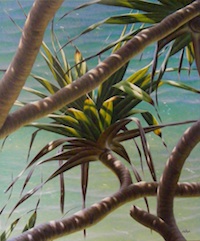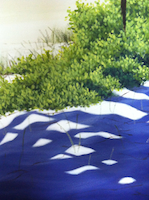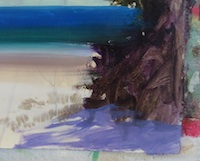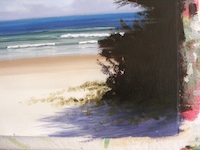Bring Your
Shadow Painting
To Life!
Discover the amazing array of colours
within shadows, and the tricks to using
them to create amazing paintings.
Shadow painting doesn’t mean dancing around with a paintbrush in front of a light. (Although, whatever tickles your fancy......please, no photos.....).

It’s easy to think of shadows just as shadows. Shadow painting can be a wonderful way of introducing more life, depth, dimension and colour to your work.
The way you paint your shadows can make or break your paintings.
For the purposes of this tutorial, we’ll break our shadow painting into two groups:
Shadows ON something - so in other words, a shadow being cast onto a tree trunk, or grass or a wall, for example.
Shadows IN something - the darks amongst the foliage of a tree, for example.
The shadows IN something can give volume, depth and dimension to the object being painted. The shadows ON something create planes within your picture (horizontal and vertical planes).

We’ve all seen the row of fence posts/telegraph poles receding into the distance with the shadows being cast onto the ground.
It’s important how you approach this example of shadow painting.
The way you paint the shadows on the ground adds to the illusion of a roughly horizontal plane receding.
Shadows ON Something - I love painting shadows on stuff. Not only can you get a sense of the plane that the shadow falls on, but it also gives you information about the object that is casting the shadow.
I mentioned trees before - what a wonderful thing it is to paint the dappled light that finds its way through the leaves of a tree. Think of the impressionists.

The other magical thing about shadows ON something, is that you can use them to “form” the structure of the objects the shadow is landing on.
This is a fantastic thing to be aware of when painting shadows. As an example, the way shadows fall on sand will be very different from the way shadows form the shape of shrubs.
Adjusting your brush technique accordingly will help give realism to your shadow painting. Shadows can also be incredibly beautiful in their own right, and in fact can often be the entire subject of a painting.

The other interesting thing about these shadows, is that they are often a wonderful opportunity to add colour! Often, we only give our shadows fairly brief attention. In reality though, there is a lot happening in them, often much more colour than you would imagine.
As an example I often paint the shadows cast on the sand in a spectacular purple hue. When you focus on it, it can look a little strange. But in the context of the painting it adds a whole new dimension.
Recapping on this: think of shadows ON something as creating depth, dimension, and an opportunity for colour.

Shadows IN Something - Obviously these will create the illusion of depth and dimension in your shadow painting, but can aid the illusion of volume as well.
These can be VERY dark.
The thing to watch when painting very dark shadows, is to not create a “Black Space Of Dooooooooom”.
Light bounces around everywhere, including into and out of your shadows. Make sure while creating the illusion of volume with your shadows, that you take the time to observe colour.
As before this is a wonderful opportunity to add colour (and some more life) to your paintings.
Mini Exercise:
Shadows On:
In these examples (see photographs to the right), I’ve used a wonderful White, Dioxazine Purple, French Ultramarine Blue and a teensy bit of Cadmium Yellow Medium as the shadows on the sand.
I’ve placed this colour quite strategically, to give the illusion of either flat or slightly uneven ground. You can even shape footprints in the sand using this technique. Notice that as the shadows recede away from you, they are slightly paler and “bluer”.

Your turn!
Get yourself a white canvas and paint a fencepost on it. Paint a shadow coming away from the bottom of the post.
You can change the angle of the bank that the post is sitting on by altering the direction and shapes of the shadow.
Experiment with this on your blank canvas. Play around with a shadow that runs along the ground and then travels up onto something, like a rock or possibly a tree trunk.

Consider what a shadow would look like when falling onto long grass. When you start playing with this, you can see how the shadows ON something can create more interest in your work.
Muck around with altering the hue as the shadow recedes away from you. Making the furthest part of the shadow a little paler can add to the illusion of depth. Hours of fun!

Shadows In:
Have a quick look at these photos. When there are shadows in the trees, you will notice there is also a lot of colour.
Dig out an old “dead” landscape painting (one that got the better of you), with some nice dark shadows in it.

You have nothing to lose! Use the edge of your brush, and put some little flecks of colour, warm and cool, light and dark, to create the illusion of sunlight hitting leaves and branches.
Make sure to put some deeper, cooler colours to suggest detail “deeper” in the dark area.

If your thing isn’t landscape, see how adding some colours to shadows, however subtle, can give them some zing.
Go out into the world and look for this. You’ll be amazed at how much colour is hiding in the shadows, waiting to be discovered.
I get so excited about this I wanna jump up and down!!!
Check out our "Over The Shoulder"
tutorial for
painting shadows below!

















New! Comments
Have your say about what you just read! Leave me a comment in the box below.